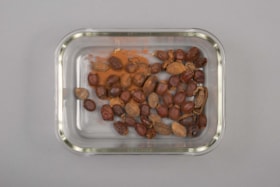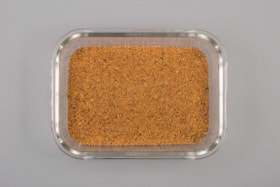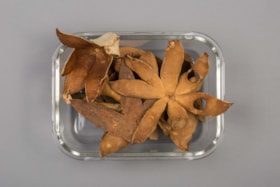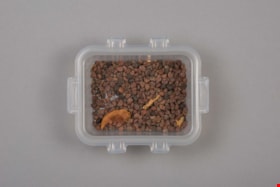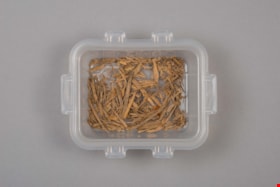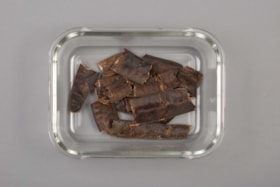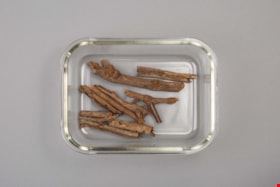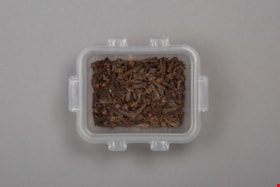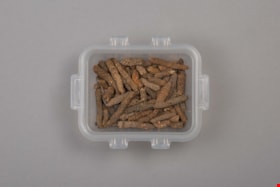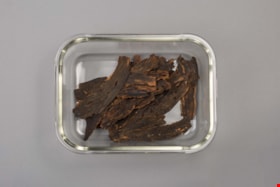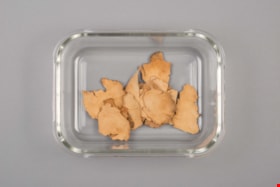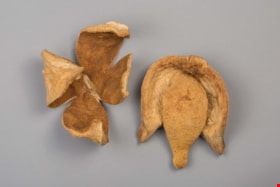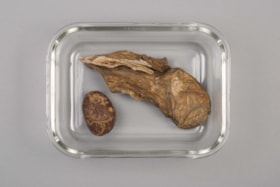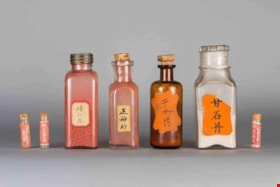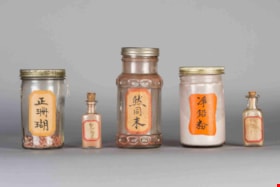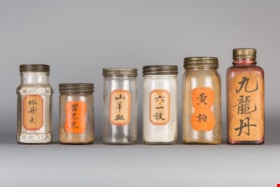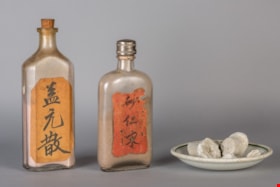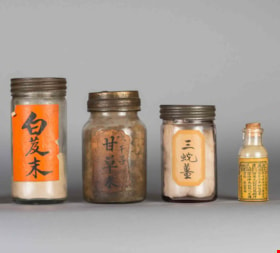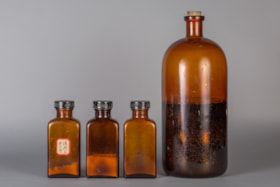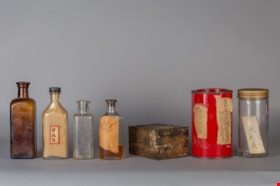Narrow Results By
Subject
- Agriculture 1
- Agriculture - Farms 1
- Agriculture - Ranches 1
- Animals - Pigs 1
- Buildings - Civic - Museums 3
- Buildings - Schools 1
- Clothing - Uniforms 1
- Data Processing Tools and Equipment 1
- Food Processing Tools and Equipment 1
- Food Service Tools and Equipment 4
- Organizations 4
- Organizations - Societies and Clubs 2
Creator
- Burnaby Village Museum 2
- Debbie Liang 1
- Hall, H.S. (Henry Sinclair), 1848-1934 1
- Inoue, Tetsujiro, 1856-1944 2
- Kallberg, Kent 5
- Knight, S.R. (Samuel Ratcliffe) 1
- Liang, Debbie 1
- Lobscheid, W. (William) 2
- UBC Initiative for Student Teaching and Research in Chinese Canadian Studies 1
- University of British Columbia 1
- Way Sang Yuen Wat Kee & Company 1
- White, Ellen G., 1827-1915 1
botanical specimen
https://search.heritageburnaby.ca/link/museumartifact88660
- Repository
- Burnaby Village Museum
- Accession Code
- BV017.7.32
- Description
- English Name: Villous Amomun Fruit Chinese Pinyin Name: Sharen (ShaRen / SuoShaMiRen) Physical Description: many small dried fruits, flattened ovals, ranging from pale tan to darker reddish brown colour; some have longitudinal ridges, others appear wrinkled, with stem protrusion one end or hole; at least one is broken open Production Regions: Primarily produced in the Chinese provinces of Guangdong, Guangxi. Imported sha ren is produced in Vietnam, Thailand, Myanmar, and Indonesia. Functions: Transforms dampness, increases appetite, warms spleen, relieves diarrhea, regulates qi, calms fetus. Apply to retention of dampness in the middle, abdominal fullness and anorexia, deficiency and cold spleen and stomach, vomit and diarrhea, pernicious vomiting, restless fetal movements.
- Object History
- Collection of original raw contents of the Chinese Herbalist Shop, Way Sang Yuen Wat Kee, Victoria BC, as purchased from Rodney Pain in 1974.
- Reference
- Chinese Medicinal Material Images Database, School of Chinese Medicine, Hong Kong Baptist University. URL: http://libproject.hkbu.edu.hk/was40/detail?channelid=47953&lang=eng&searchword=pid=B00254 ; Compendium of Materia Medica (Bencao Gangmu), 2003;
Images
botanical specimen
https://search.heritageburnaby.ca/link/museumartifact88666
- Repository
- Burnaby Village Museum
- Accession Code
- BV017.7.38
- Description
- mustard seed; used internally to discharge mucus
- Object History
- Collection of original raw contents of the Chinese Herbalist Shop, Way Sang Yuen Wat Kee, Victoria BC, as purchased from Rodney Pain in 1974.
- Reference
- Keys, John D. "Chinese Herbs". Rutland: Charles E Tuttle Company, Inc., 1976.
Images
botanical specimen
https://search.heritageburnaby.ca/link/museumartifact88669
- Repository
- Burnaby Village Museum
- Accession Code
- BV017.7.41
- Description
- mandarin orange peel (Citrus Nobilis); used to sooth the stomach, to aid digestion, to discharge mucus
- Object History
- Collection of original raw contents of the Chinese Herbalist Shop, Way Sang Yuen Wat Kee, Victoria BC, as purchased from Rodney Pain in 1974. Orange Peel is used as a traditional seasoning in Chinese cooking and in traditional medicine. Today, orange peel essential oil is a common beauty product used around the world.
- Reference
- Keys, John D. "Chinese Herbs". Rutland: Charles E Tuttle Company, Inc., 1976.
Images
botanical specimen
https://search.heritageburnaby.ca/link/museumartifact88671
- Repository
- Burnaby Village Museum
- Accession Code
- BV017.7.43
- Description
- English Name: Pharbitis Seed / Lobedleaf Pharbitis Seed Chinese Pinyin Name: Qianniuzi (QianNiuZi) Physical Description: many small dried seeds, colours vary from light tan to dark brown; wedge-shaped with curved backs, like orange segments; backs have single groove Production Regions: Primarily produced in the Chinese provinces of Guangxi, Yunnan. Functions: Drains water, frees stools, eliminates phlegm, clears fluid, kills worms, attacks stagnation. Apply to edema and fullness, fecal and urinary stoppage, inverse qi and panting, worm stagnation and abdominal pain, ascariasis, taeniasis.
- Object History
- Collection of original raw contents of the Chinese Herbalist Shop, Way Sang Yuen Wat Kee, Victoria BC, as purchased from Rodney Pain in 1974.
- Reference
- Chinese Medicinal Material Images Database, School of Chinese Medicine, Hong Kong Baptist University. URL: http://libproject.hkbu.edu.hk/was40/detail?channelid=47953&lang=eng&searchword=pid=B00198 Compendium of Materia Medica (Bencao Gangmu), 2003; Taiwan Herbal Pharmacopeia, 2014.
Images
botanical specimen
https://search.heritageburnaby.ca/link/museumartifact88673
- Repository
- Burnaby Village Museum
- Accession Code
- BV017.7.45
- Description
- English Name: Chinese Eaglewood / Tambac Chinese Pinyin Name: Chenxiang (ChenXiang) Physical Description: wood fragments, small, light to medium brown; thin shavings or splinters in varying sizes Production Regions: Primarily produced in the Chinese provinces of Guangdong, Hainan, Guangxi, Fujian, Taiwan. Functions: Moves qi and relieves pain, warms the center and stops vomiting, promotes qi absorption and calms panting. Apply to chest and abdominal swelling pain, gastric cold and vomiting and hiccoughs, deficiency of kidney and inability to breathe due to adverse rising of qi.
- Object History
- Collection of original raw contents of the Chinese Herbalist Shop, Way Sang Yuen Wat Kee, Victoria BC, as purchased from Rodney Pain in 1974.
- Reference
- Chinese Medicinal Material Images Database, School of Chinese Medicine, Hong Kong Baptist University. URL: http://libproject.hkbu.edu.hk/was40/detail?channelid=47953&lang=eng&searchword=pid=B00421 Compendium of Materia Medica (Bencao Gangmu), 2003; Taiwan Herbal Pharmacopeia, 2014.
Images
botanical specimen
https://search.heritageburnaby.ca/link/museumartifact88674
- Repository
- Burnaby Village Museum
- Accession Code
- BV017.7.46
- Description
- English Name: Chinese Honeylocust Abnormal Fruit / Abnorma Chinese Honeylocust Fruit Chinese Pinyin Name: Zhuyazao (ZhuYaZao) Physical Description: dried fruit, large flat rectangular pieces torn from larger pods, dark brown with lighter brown areas; some pieces are curved along one side; leathery surfaces with creases and tears, and fraying along torn edges Production Regions: Primarily produced in the Chinese provinces of Shandong, Yunnan, Guizhou, Sichuan. Functions: Opens orifices, transforms phlegm, dispels wind, kills worms. Apply to apoplexy and lockjaw, head wind, inveterate wind evil, throat impediment, panting with phlegm, distention and fullness accumulation, blocking orifices, swelling abscess, ulcer, tinea, head sore
- Object History
- Collection of original raw contents of the Chinese Herbalist Shop, Way Sang Yuen Wat Kee, Victoria BC, as purchased from Rodney Pain in 1974.
- Reference
- Chinese Medicinal Material Images Database, School of Chinese Medicine, Hong Kong Baptist University. URL: http://libproject.hkbu.edu.hk/was40/detail?channelid=47953&lang=eng&searchword=pid=B00225; Compendium of Materia Medica (Bencao Gangmu), 2003; Taiwan Herbal Pharmacopeia, 2014.
Images
botanical specimen
https://search.heritageburnaby.ca/link/museumartifact88675
- Repository
- Burnaby Village Museum
- Accession Code
- BV017.7.47
- Description
- English Name: Cassia bark tree Twig Chinese Pinyin Name: Guizhi (GuiZhi) Physical Description: twigs, short, light brown, varying thicknesses, with some ridging and wrinkling along their lengths; some have short pieces branching off, some show a scar where a branching piece has broken off; some are cut or broken to blunt ends, others have bark missing at end, some have protruding bark ends with no wood inside Production Regions: Primarily produced in the Chinese provinces of Fujian, Guangdong, Guangxi. Functions: Promotes sweating, resolves the flesh, warms and frees the channels and vessels, assists yang in transforming qi, downbears qi. Apply to wind-cold type of common cold, abdominal cold pain, amenorrhea due to cold blood, joint impediment, phlegm and retained fluid, edema, palpitations, renal mass.
- Object History
- Collection of original raw contents of the Chinese Herbalist Shop, Way Sang Yuen Wat Kee, Victoria BC, as purchased from Rodney Pain in 1974. Cassia bark twig is also known as Chinese cinnamon and has been used in Chinese medicine for centuries. Most of the cinnamon sold in Canada’s supermarkets is Chinese cinnamon.
- Reference
- Chinese Medicinal Material Images Database, School of Chinese Medicine, Hong Kong Baptist University. URL: http://libproject.hkbu.edu.hk/was40/detail?channelid=47953&lang=eng&searchword=pid=B00138 Compendium of Materia Medica (Bencao Gangmu), 2003; Taiwan Herbal Pharmacopeia, 2014.
Images
botanical specimen
https://search.heritageburnaby.ca/link/museumartifact88680
- Repository
- Burnaby Village Museum
- Accession Code
- BV017.7.52
- Description
- English Name: Clove Chinese Pinyin Name: Dingxiang (DingXiang) Physical Description: small dried flower buds, dark brown and twiglike with rounded heads held by 4 sepals; lower portions are slightly tapered and rough Production Regions: Primarily produced in Zanzibar Island of Tanzania, as well as Malaysia and Indonesia. In China, it has been introduced into cultivation in the provinces of Hainan and Guangdong. Functions: Warms stomach, warms kidney. Apply to cold stomach and swelling pain, hiccup, vomiting and diarrhea, impediment, colic, ozostomia, toothache.
- Object History
- Collection of original raw contents of the Chinese Herbalist Shop, Way Sang Yuen Wat Kee, Victoria BC, as purchased from Rodney Pain in 1974.
- Reference
- Chinese Medicinal Material Images Database, School of Chinese Medicine, Hong Kong Baptist University. URL: http://libproject.hkbu.edu.hk/was40/detail?channelid=47953&lang=eng&searchword=pid=B00299 ; Compendium of Materia Medica (Bencao Gangmu), 2003;
Images
botanical specimen
https://search.heritageburnaby.ca/link/museumartifact88681
- Repository
- Burnaby Village Museum
- Accession Code
- BV017.7.53
- Description
- English Name: Long Pepper Fruit
- Chinese Pinyin Name: Bibo (Bibo)
- Physical Description: small medium-brown cylindrical fruit spikes of similar length and thickness, slight curve visible in some; small protuberances evenly distributed along pieces
- Production Regions: Primarily produced in Indonesia.
- Functions: Warms the center, disperses cold, downbears qi, relieves pain. Apply to cold pain of gastric cavity and abdomen, vomiting, diarrhea, nasosinusitis, hemicrania, externally used for toothache, coronary disease, angina pectoris; heart and abdominal cold pain, vomiting and sour regurgitation, diarrhea with intestine rumbling, cold diarrhea, yin hernia, headache, toothache.
- Object History
- Collection of original raw contents of the Chinese Herbalist Shop, Way Sang Yuen Wat Kee, Victoria BC, as purchased from Rodney Pain in 1974.
- Reference
- Chinese Medicinal Material Images Database, School of Chinese Medicine, Hong Kong Baptist University. URL: http://libproject.hkbu.edu.hk/was40/detail?channelid=47953&lang=eng&searchword=pid=B00156
Images
botanical specimen
https://search.heritageburnaby.ca/link/museumartifact88683
- Repository
- Burnaby Village Museum
- Accession Code
- BV017.7.55
- Description
- English Name: Lobed Kudzuvine Root Chinese Pinyin Name: Gegen (GeGen) Physical Description: roots, dried, flat, rough dark brown surfaces with longitudinal wrinkles; mostly rectangular but tapered in places Production Regions: Primarily produced in the Chinese provinces of Henan, Zhejiang, Guangdong, Hunan. Functions: Resolves exterior, abates heat, engenders fluid, outthrusts measles, raise yang, relieves diarrhea. Apply to fever and headache caused by exogenous pathogens, stiffness of the neck due to hypertension, hydrodipsia, diabetes, measles without adequate eruptions, dysentery of heat type, diarrhea.
- Object History
- Collection of original raw contents of the Chinese Herbalist Shop, Way Sang Yuen Wat Kee, Victoria BC, as purchased from Rodney Pain in 1974.
- Reference
- Chinese Medicinal Material Images Database, School of Chinese Medicine, Hong Kong Baptist University. URL: http://libproject.hkbu.edu.hk/was40/detail?channelid=47953&lang=eng&searchword=pid=B00063 Compendium of Materia Medica (Bencao Gangmu), 2003; Taiwan Herbal Pharmacopeia, 2014.
Images
botanical specimen
https://search.heritageburnaby.ca/link/museumartifact88693
- Repository
- Burnaby Village Museum
- Accession Code
- BV017.7.65
- Description
- English Name: Hypoglaucous Collett Yam Rhizome/ Hypoglaucous Yam Rhizome Chinese Pinyin Name: Fenpixie (FenPiXie) Physical Description: thin slices of rhizome, large, medium tan colour, irregular edges and shapes; surface is slightly rough; colour is darker and texture rougher or wrinkled near some edges; some pieces have cracks or tears in edges Functions: Promotes urination, dispels wind, promotes removing damp. Apply to wind and damp impediment, pain of waist and knees, dysuria, stranguria with turbid discharge, spermatorrhea, sore toxin due to damp and heat
- Object History
- Collection of original raw contents of the Chinese Herbalist Shop, Way Sang Yuen Wat Kee, Victoria BC, as purchased from Rodney Pain in 1974.
- Reference
- Chinese Medicinal Material Images Database, School of Chinese Medicine, Hong Kong Baptist University. URL: http://libproject.hkbu.edu.hk/was40/detail?channelid=47953&lang=eng&searchword=pid=B00056 Compendium of Materia Medica (Bencao Gangmu), 2003; Taiwan Herbal Pharmacopeia, 2014.
Images
botanical specimen
https://search.heritageburnaby.ca/link/museumartifact88698
- Repository
- Burnaby Village Museum
- Accession Code
- BV017.7.70
- Description
- English Name: Tomentose Pummelo Peel Chinese Pinyin Name: Huajuhong (HuaJuHong / YouPi) Physical Description: large pieces of dried fruit peel, medium tan colour; intact peel is inside-out, has 4 points curving inwards; outer peel is finely pitted, inner peel is whitish with veins; 1 point broken off halfway, another near tip Production Regions: Primarily produced in the Chinese area of Huazhou and Lianjiang of Guangdong. Functions: Disperses cold, dries dampness, promotes qi, eliminates phlegm. Apply to cough due to wind-cold, itching throat with phlegm, dyspepsia and chronic alcoholism, vomiting, nausea, painful abdominal mass.
- Object History
- Collection of original raw contents of the Chinese Herbalist Shop, Way Sang Yuen Wat Kee, Victoria BC, as purchased from Rodney Pain in 1974.
- Reference
- Chinese Medicinal Material Images Database, School of Chinese Medicine, Hong Kong Baptist University. URL: http://libproject.hkbu.edu.hk/was40/detail?channelid=47953&lang=eng&searchword=pid=B00183 ; http://libproject.hkbu.edu.hk/was40/detail?channelid=1288&lang=en&record=1&searchword=herb_id=%27D00050%27%20OR%20herb_id=%27D00051%27 ; Compendium of Materia Medica (Bencao Gangmu), 2003;
- Marks/Labels
- See HV975.5.1165 for label that likely accompanied the pummelo peel.
Images
botanical specimen
https://search.heritageburnaby.ca/link/museumartifact88702
- Repository
- Burnaby Village Museum
- Accession Code
- BV017.7.74
- Description
- English Name: Pubescent Angelica Root Chinese Pinyin Name: Duhuo (DuHuo / DuHuoGen) Physical Description: piece of dried root, brown, roughly rectangular, outward curve along one side, straighter along other side with one triangular protrusion; thicker at one end with smooth dark brown surface, some wrinkles, while other end tapers to a point; from mid-point to tapered end root appears to have many thin vertical layers varying in colour from light tan to medium brown Production Regions: Primarily produced in the Chinese provinces of Sichuan, Hubei. Functions: Dispels wind, eliminates dampness, frees cold, stops pain. apply to wind-cold and damp
- Object History
- Collection of original raw contents of the Chinese Herbalist Shop, Way Sang Yuen Wat Kee, Victoria BC, as purchased from Rodney Pain in 1974.
- Reference
- Chinese Medicinal Material Images Database, School of Chinese Medicine, Hong Kong Baptist University. URL: http://libproject.hkbu.edu.hk/was40/detail?channelid=47953&lang=eng&searchword=pid=B00052 Compendium of Materia Medica (Bencao Gangmu), 2003; Taiwan Herbal Pharmacopeia, 2014; Hong Kong Chinese Materia Medica Standards Volume 2. Retrived on 25 July 2017. URL: http://www.cmd.gov.hk/doc/search/Radix_Angelicae_Pubescentis_v2_e.pdf
Images
bottle
https://search.heritageburnaby.ca/link/museumartifact23723
- Repository
- Burnaby Village Museum
- Accession Code
- HV975.5.65
- Description
- Brown glass bottle with narrow neck; cork lid; orange paper label with 3 chinese characters. Artifact is fifth from left in the photograph.
- Object History
- This item originates from the Chinese Herbalist Store "Way Sang Yuen Wat Kee & Co.", Victoria B.C.
- Classification
- Chemical T&E
- Marks/Labels
- Chinese characters on label, which literally translate to "medicine".
- Measurements
- 11cm height x 5cm width
Images
bottle
https://search.heritageburnaby.ca/link/museumartifact23725
- Repository
- Burnaby Village Museum
- Accession Code
- HV975.5.67
- Description
- Bottle, clear, with bubble-like pattern on upper and lower edges; brick-colored residue stuck to the inside; metal colored screw-cap lid; yellow paper label with red border and label 3 Chinese characters. Article is third (middle) from the left in photograph.
- Object History
- This item originates from the Chinese Herbalist Store "Way Sang Yuen Wat Kee & Co.", Victoria B.C.
- Classification
- Chemical T&E
- Marks/Labels
- Yellow paper label with red border and label 3 Chinese characters which literally translate to "however/correct," "same/similar" and "powder". English translation adjusted to Pyritum. Pyritum or iron pyrite is an iron sulfide mainly containing FeS2. It is used to treat traumatic injuries, broken tendons and bone fracture, soft tissue injuries, swelling, blood stasis, pain, carbuncles, sores, and burns. It alleviates pain and dissolves stasis.
- Measurements
- 11 cm in height x 4.5 cm in width (diameter)
Images
bottle
https://search.heritageburnaby.ca/link/museumartifact23726
- Repository
- Burnaby Village Museum
- Accession Code
- HV975.5.68
- Description
- Glass bottle with metal twist-on lid. Top 1/4 straight then a lip with circles around bottle. Straight down with vertical grooves to the bottom lip with circles. Some white unknown contents inside. Brown with orange trim label wih Chinese characters. Artifact is first on the left in photograph.
- Object History
- This item originates from the Chinese Herbalist Store "Way Sang Yuen Wat Kee & Co.", Victoria, B.C.
- Classification
- Chemical T&E
- Marks/Labels
- Brown octagonal label with orange trim. Chinese characters on label that literally translate to: [indistinguishable] and "pellet" and [indistinguishable].
- Measurements
- 14 cm height x 5 cm width
Images
bottle
https://search.heritageburnaby.ca/link/museumartifact23728
- Repository
- Burnaby Village Museum
- Accession Code
- HV975.5.70
- Description
- Clear glass bottle with oval base, narrow neck and cork. Bottle has hand-written yellow label. Bottle is two-thirds full of a pale pink powder. Object is first on the left in photograph.
- Object History
- This item originates from the Chinese Herbalist Store "Way Sang Yuen Wat Kee & Co.", Victoria B.C.
- Classification
- Chemical T&E
- Marks/Labels
- Label contains 3 Chinese characters that are literally translated to :"lid" and "dollar/yuan" and "scatter".
- Measurements
- 20 cm height x 5 cm width x 2 cm length
Images
Bottle
https://search.heritageburnaby.ca/link/museumartifact23783
- Repository
- Burnaby Village Museum
- Accession Code
- HV975.5.125
- Description
- Clear glass round-based bottle with cork and printed paper label. Artifact is fifth from left in photograph.
- Object History
- This item originates from the Chinese Herbalist Store "Way Sang Yuen Wat Kee & Co.", Victoria B.C.
- Classification
- Chemical T&E
- Marks/Labels
- Yellow label with black text. Label contains Chinese characters that are literally translated to: "Watson's" and "home" and "made" and "top" and "up" and "Quinine" and "powder". When adjusted for English comprehension, product is " Watson's Quinine powder". Quinine is a treatment for malaria. It is also used to treat lupus and arthritis. Quinine was also frequently prescribed as an off-label treatment for leg cramps at night, but this has become less common due to a Food and Drug Administration warning that this practice is associated with life-threatening side effects. Brand name "Watsons" is for A.S. Watson Group, which started as the Canton Dispensary and Soda Water Establishment in 1828 as a small dispensary, with the mission to provide free medical services to the poor people of the Southern Chinese province of Guangdong (also known as Canton). It moved to Hong Kong and re-emerged as the Hong Kong Dispensary in 1843. The company began trading under the name A.S. Watson & Company in 1871. Now, the A.S. Watson Group (or A.S. Watson or ASW) with headquarters located in Hong Kong, is the world's largest health and beauty retail group, with over 13,900 stores in 24 markets worldwide serving over 28 million customers per week, and over 3 billion customers and members throughout.
- Measurements
- 10 cm height x 2 cm legth x 2 cm width
Images
bottle
https://search.heritageburnaby.ca/link/museumartifact23790
- Repository
- Burnaby Village Museum
- Accession Code
- HV975.5.132
- Description
- Amber or brown glass, rectangular with short neck and black plastic screw-cap. Rectangular paper label with handwritten text in black ink and red border. 1/4 filled with light-coloured powder. Object is first on left in photograph.
- Object History
- This item originates from the Chinese Herbalist Store "Way Sang Yuen Wat Kee & Company," Victoria, B.C.
- Marks/Labels
- The label contains Chinese characters that are literally translated to [indistinguishable], means "autumn," means "stone," [indistinguishable].
- Measurements
- 14 cm height x 5 cm width x 5 cm depth
Images
bottle
https://search.heritageburnaby.ca/link/museumartifact23796
- Repository
- Burnaby Village Museum
- Accession Code
- HV975.5.138
- Description
- Squared clear glass bottle. Handmade torn yellowed label has Chinese characters in pencil. Bottle is 1/4 filled with an amber liquid. Artifact is fourth from the left in photograph.
- Object History
- This item originates from the Chinese Herbalist Store “Way Sang Yuen Wat Kee & Co.”, Victoria B.C.
- Measurements
- 13 cm height x 5.5 cm width
